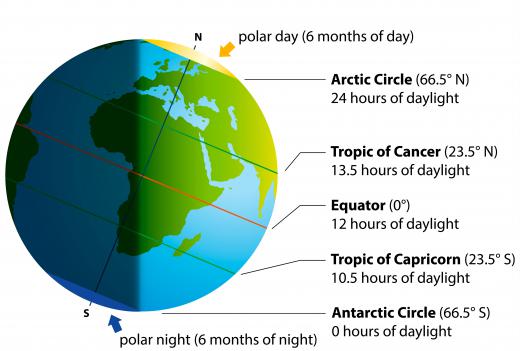What is a Temperate Zone?
The north and south temperate zones are, strictly speaking, two regions of the Earth that lie between the Tropic of Cancer and the Arctic Circle, and the Tropic of Capricorn and the Antarctic Circle, respectively. These regions may be generally supposed to have temperate, or mild, climates without extremes of temperature; however, the definition is of very limited use regarding weather. Temperature and rainfall are strongly influenced by factors other than latitude, such as topography and nearness to the ocean. As a result, extreme temperatures can occur within a temperate zone, and some areas outside them have mild climates. A more useful definition is based on temperatures and rainfall through the year.
The Koppen System

The most commonly used method for describing climates is the Koppen classification system, which has been in use, in one form or another for over 100 years. In this system, there are five main climate types, named A, B, C, D, and E. The type C — mild temperate or mesothermal — climate corresponds most closely to what is meant by temperate. It is defined as an area with average temperatures in the warmest months greater than 50°F (10°C), and with the average for the coldest month between 27 and 64°F (-3 and 18°C).

Within this type, there are further subdivisions, relating to the seasonal distribution of rainfall and temperatures, and indicated by lower case letters. An “s” indicates dry summers; a “w”, dry winters; and an “f”, rainfall throughout the year. A third letter represents summer temperatures, with an “a” indicating very warm summers, a “b”, moderately warm summers, and a “c”, relatively cool summers. Therefore, a Cfb climate would be temperate, with year-round rainfall, and fairly warm summers: a climate typical of north-western Europe, for example. Using this classification system, temperate zones fall between 40° and 60° latitude, but are subject to various geographical influences.
The Effects of Topography

Topography has two main effects on climate. Firstly, average temperatures fall with increasing altitude. Mountainous regions between the tropics and the arctic or antarctic regions therefore tend to have more severe climates than their latitudes would suggest.
Mountains also have a major effect on rainfall and humidity. As relatively warm, moist air from the ocean flows inland, it may be forced to rise by a range of mountains. As it does so, it cools, and water vapor can condense into cloud and rain. Areas on the ocean side of an elevated area will therefore tend to have a mild, wet climate, while those on the other side may be very dry, as the air has now lost most of its moisture. Since humidity has a moderating effect on temperature, these areas may experience much greater extremes.
The Effect of the Oceans

Water is relatively slow to heat up and cool down, and because of this, the oceans tend to store heat during the winter, releasing it slowly, and preventing temperatures in coastal areas from dropping very low. Conversely, in summer, they are slow to heat up, and so the effect of a large body of relatively cool water tends to prevent very high temperatures in areas near the coast. Areas that are far from the sea, such as continental interiors, therefore tend to have much hotter summers and much colder winters.
Based on this effect, a temperate zone can often be divided into oceanic — or maritime — and continental areas. The continental temperate zone is, in fact, not very temperate for much of the year. For example, Eastern Europe largely falls within this region, and is marked by very cold winters. At the same time, the region experiences fairly hot summers, allowing it to meet the temperature range requirement for this zone. There are no true continental temperate zones in the southern hemisphere because there are no masses of land large enough allow such temperature swings. Areas in the continental regions generally do not receive much precipitation, on average receiving less than 30 inches (75cm) of rain a year, although they may experience thunderstorms.
The other main classification, with a milder climate, is the oceanic temperate zone. In most of these areas it is relatively rare for winter temperatures to drop below freezing, at 32°F (0°C). This region experiences cyclonic rainfall, often as much as five to ten times greater than a continental zone. Winter rainfall is often accompanied by high winds. Although these cyclonic conditions are not in the same league as tropical cyclones, they can occasionally result in severe storms that cause significant damage.
The oceanic temperate zone does not experience temperature swings on the same scale as the continental region. During the summers, temperatures generally remain moderate, only occasionally rising far above 70°F (21°C). Similarly, in the majority of oceanic zones even during the winter the temperature seldom drops far below 40°F (4°C).
Global Distribution
Surprisingly little land mass falls within the southern temperate zone. New Zealand, part of Australia, part of Oceania, the southernmost tip of Africa, and the southern part of South America are all that are encompassed by the zone. The Northern temperate zone contains the majority of the world’s population, with the United States, most of China, part of India, much of Canada, nearly all of Europe, and a great deal of Russia.
AS FEATURED ON:
AS FEATURED ON:














Discussion Comments
I think the temperate zone is in the middle not hot nor cold but in the middle, and sometimes it will be sunny, and then it will change and start raining out of nowhere.
Let me clear something up right now! New Zealand is not part of Australia and hasn't been since the days of Gondwanaland. We are our own self sufficient country and it is a paradise! Do not be confusing our beautiful country with Australia please!! Do your research! Thank you!
@lori43 - Haha, that's a good point and a good question. Climates within the world's temperate zones are a little on the inaccurate side, I'll admit it. But if you think about it, having too many terms for relatively similar climates and geographically close regions would only confuse people. People like to have umbrella terms to categorize things, and that fact remains with regard to the established descriptions of the world's climates.
I think that the term "temperate zone" maybe a bit too vague for the huge range of climates that it covers. California and North Carolina, for instance, despite having similar latitudes and both being within the temperate zone, really couldn't feel more different. North Carolina is humid and at times, downright muggy, and far hotter than California usually mild year round climate. North Carolina has ice storms and intense lighting storms in the winter, whereas the vast majority of California winters feature little more than occasional heavy rains. Perhaps regions with not-so-temperate climates should be called "extreme temperate zones"? Does that term even make sense? Can something be extreme and temperate at the same time?
Post your comments